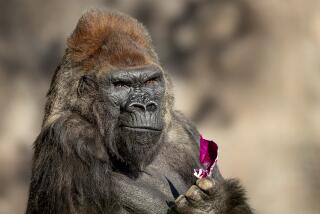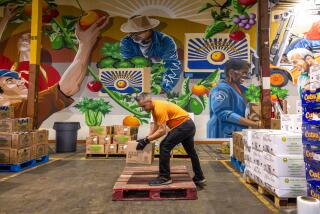Gorilla Gourmet : Volunteer Gardeners Try to Add a Little Zest to the Zoo Meals of Primates
- Share via
Every Saturday and Sunday at 6:30 a.m., the “gorilla ladies” assemble at a small plot of land in Encino, hoes and trowels in hand.
Not far from the gourmet restaurants on Ventura Boulevard, the seven volunteers lovingly cultivate succulent field corn, sweet-potato vines, giant sunflowers, string beans, carnations, African daisies, petunias, pansies and squash.
And they are doing it all for the gorillas and other primates at the Los Angeles Zoo.
In a horticultural project started by the zoo’s research department, the gourmet food is designed to bring more foliage and--perhaps most important--more interest and excitement into the primates’ lives.
Volunteers are called the “gorilla ladies” by fellow gardeners at the Sepulveda Garden Center on Magnolia Boulevard, which is managed by the Department of Recreation and Parks. (Gardeners must place their names on a waiting list to get a free plot.)
Grow and Deliver
The volunteers plant, weed, cultivate and fertilize their 2,200-square-foot, 12-plot garden on Saturday mornings and return on Sundays to harvest their delicacies and personally deliver the bounty to the primates at the zoo. The zoo and the volunteers share the cost.
Thaya duBois, assistant director of research at the Los Angeles Zoo and manager of the Gorilla Garden project, said she started the project more than two years ago by asking for help in a letter to zoo volunteers.
Its purpose is to provide the gorillas with diversion and variety in their diets.
Wild primates spend almost half their days foraging for food, said duBois, a primate specialist. They strip trees of bark, dig roots and pick seeds. The traditional zoo diet--monkey chow (similar to dog chow) and assorted vegetables--deprives the primates of their usual food-gathering exercise.
For the gorillas and their fellow primates, peeling, mashing and plucking the colorful gourmet food is half the fun, she said.
‘To Relieve Their Boredom’
“We’ve known for quite a while that the animals enjoyed eating flowers, but we never had enough to satisfy them. We’re always trying to think of naturalist things to relieve their boredom,” duBois said.
The volunteers also seek out donations of pesticide-free grapes, mulberry branches, hibiscus, roses, and other edible plants and flowers.
Sharron Amster, 47, of Van Nuys, has been volunteering Saturdays and Sundays at the garden since it was started. She said the primates love to pull the corn out of the husks and rub the soft corn silk on their faces. “The food we grow is interesting for the animals; it gives them something to do,” she said.
Ben Gonzales, a zoo veterinarian, said that although the food supplements the primate’s nutrition and provide additional bulk, “the true value of the gorilla gardening project is that it increases the quality of life for the primates.”
DuBois, who is conducting research on the value of gourmet food for gorillas, said gorillas in captivity often indulge in a routine of ingesting, regurgitating and reingesting their food.
She said she wonders if this eating behavior is caused by a lack of foraging opportunities and boredom, and she believes food that takes longer to eat will decrease this behavior.
There are tentative plans to move the gorilla garden to the zoo so that it can operate more like a small zoo farm, duBois said. It would continue to be supported by volunteers, who seem enthusiastic about their job.
“Working in the gorilla garden is probably the neatest thing I’ve ever done,” said volunteer Charlotte Shoaff, 60, of North Hollywood. “It’s pragmatic, simple work. We have fun; we laugh and we snicker, and nobody has to be president. The weekends are short, but it’s worth every minute of our time.”
DuBois said, “Some people feel a real need to do something personal for the animals.”
And there are signs that the feelings are mutual. Amster said that when the volunteers arrive every Sunday at the back of the gorilla compound with the week’s harvest, the animals seem to recognize them.
“They know our cars,” she said.






